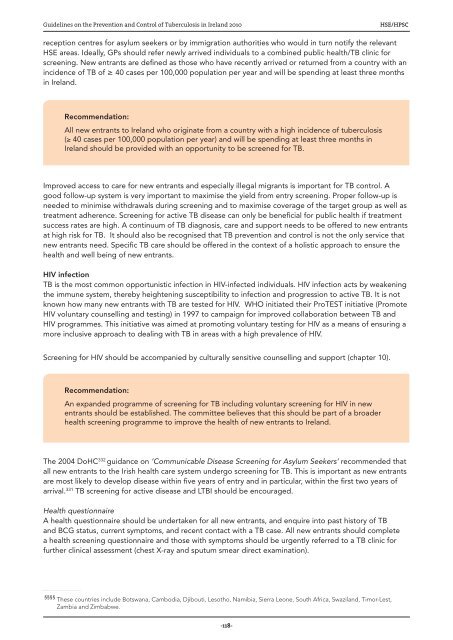Guidelines on the Prevention and Control of Tuberculosis in Ireland
Guidelines on the Prevention and Control of Tuberculosis in Ireland
Guidelines on the Prevention and Control of Tuberculosis in Ireland
You also want an ePaper? Increase the reach of your titles
YUMPU automatically turns print PDFs into web optimized ePapers that Google loves.
<str<strong>on</strong>g>Guidel<strong>in</strong>es</str<strong>on</strong>g> <strong>on</strong> <strong>the</strong> Preventi<strong>on</strong> <strong>and</strong> C<strong>on</strong>trol <strong>of</strong> <strong>Tuberculosis</strong> <strong>in</strong> Irel<strong>and</strong> 2010HSE/HPSCrecepti<strong>on</strong> centres for asylum seekers or by immigrati<strong>on</strong> authorities who would <strong>in</strong> turn notify <strong>the</strong> relevantHSE areas. Ideally, GPs should refer newly arrived <strong>in</strong>dividuals to a comb<strong>in</strong>ed public health/TB cl<strong>in</strong>ic forscreen<strong>in</strong>g. New entrants are def<strong>in</strong>ed as those who have recently arrived or returned from a country with an<strong>in</strong>cidence <strong>of</strong> TB <strong>of</strong> ≥ 40 cases per 100,000 populati<strong>on</strong> per year <strong>and</strong> will be spend<strong>in</strong>g at least three m<strong>on</strong>ths<strong>in</strong> Irel<strong>and</strong>.Recommendati<strong>on</strong>:All new entrants to Irel<strong>and</strong> who orig<strong>in</strong>ate from a country with a high <strong>in</strong>cidence <strong>of</strong> tuberculosis(≥ 40 cases per 100,000 populati<strong>on</strong> per year) <strong>and</strong> will be spend<strong>in</strong>g at least three m<strong>on</strong>ths <strong>in</strong>Irel<strong>and</strong> should be provided with an opportunity to be screened for TB.Improved access to care for new entrants <strong>and</strong> especially illegal migrants is important for TB c<strong>on</strong>trol. Agood follow-up system is very important to maximise <strong>the</strong> yield from entry screen<strong>in</strong>g. Proper follow-up isneeded to m<strong>in</strong>imise withdrawals dur<strong>in</strong>g screen<strong>in</strong>g <strong>and</strong> to maximise coverage <strong>of</strong> <strong>the</strong> target group as well astreatment adherence. Screen<strong>in</strong>g for active TB disease can <strong>on</strong>ly be beneficial for public health if treatmentsuccess rates are high. A c<strong>on</strong>t<strong>in</strong>uum <strong>of</strong> TB diagnosis, care <strong>and</strong> support needs to be <strong>of</strong>fered to new entrantsat high risk for TB. It should also be recognised that TB preventi<strong>on</strong> <strong>and</strong> c<strong>on</strong>trol is not <strong>the</strong> <strong>on</strong>ly service thatnew entrants need. Specific TB care should be <strong>of</strong>fered <strong>in</strong> <strong>the</strong> c<strong>on</strong>text <strong>of</strong> a holistic approach to ensure <strong>the</strong>health <strong>and</strong> well be<strong>in</strong>g <strong>of</strong> new entrants.HIV <strong>in</strong>fecti<strong>on</strong>TB is <strong>the</strong> most comm<strong>on</strong> opportunistic <strong>in</strong>fecti<strong>on</strong> <strong>in</strong> HIV-<strong>in</strong>fected <strong>in</strong>dividuals. HIV <strong>in</strong>fecti<strong>on</strong> acts by weaken<strong>in</strong>g<strong>the</strong> immune system, <strong>the</strong>reby heighten<strong>in</strong>g susceptibility to <strong>in</strong>fecti<strong>on</strong> <strong>and</strong> progressi<strong>on</strong> to active TB. It is notknown how many new entrants with TB are tested for HIV. WHO <strong>in</strong>itiated <strong>the</strong>ir ProTEST <strong>in</strong>itiative (PromoteHIV voluntary counsell<strong>in</strong>g <strong>and</strong> test<strong>in</strong>g) <strong>in</strong> 1997 to campaign for improved collaborati<strong>on</strong> between TB <strong>and</strong>HIV programmes. This <strong>in</strong>itiative was aimed at promot<strong>in</strong>g voluntary test<strong>in</strong>g for HIV as a means <strong>of</strong> ensur<strong>in</strong>g amore <strong>in</strong>clusive approach to deal<strong>in</strong>g with TB <strong>in</strong> areas with a high prevalence <strong>of</strong> HIV.Screen<strong>in</strong>g for HIV should be accompanied by culturally sensitive counsell<strong>in</strong>g <strong>and</strong> support (chapter 10).Recommendati<strong>on</strong>:An exp<strong>and</strong>ed programme <strong>of</strong> screen<strong>in</strong>g for TB <strong>in</strong>clud<strong>in</strong>g voluntary screen<strong>in</strong>g for HIV <strong>in</strong> newentrants should be established. The committee believes that this should be part <strong>of</strong> a broaderhealth screen<strong>in</strong>g programme to improve <strong>the</strong> health <strong>of</strong> new entrants to Irel<strong>and</strong>.The 2004 DoHC 332 guidance <strong>on</strong> ‘Communicable Disease Screen<strong>in</strong>g for Asylum Seekers’ recommended thatall new entrants to <strong>the</strong> Irish health care system undergo screen<strong>in</strong>g for TB. This is important as new entrantsare most likely to develop disease with<strong>in</strong> five years <strong>of</strong> entry <strong>and</strong> <strong>in</strong> particular, with<strong>in</strong> <strong>the</strong> first two years <strong>of</strong>arrival. 331 TB screen<strong>in</strong>g for active disease <strong>and</strong> LTBI should be encouraged.Health questi<strong>on</strong>naireA health questi<strong>on</strong>naire should be undertaken for all new entrants, <strong>and</strong> enquire <strong>in</strong>to past history <strong>of</strong> TB<strong>and</strong> BCG status, current symptoms, <strong>and</strong> recent c<strong>on</strong>tact with a TB case. All new entrants should completea health screen<strong>in</strong>g questi<strong>on</strong>naire <strong>and</strong> those with symptoms should be urgently referred to a TB cl<strong>in</strong>ic forfur<strong>the</strong>r cl<strong>in</strong>ical assessment (chest X-ray <strong>and</strong> sputum smear direct exam<strong>in</strong>ati<strong>on</strong>).____________________________________________________§§§§ These countries <strong>in</strong>clude Botswana, Cambodia, Djibouti, Lesotho, Namibia, Sierra Le<strong>on</strong>e, South Africa, Swazil<strong>and</strong>, Timor-Lest,Zambia <strong>and</strong> Zimbabwe.-118-
















